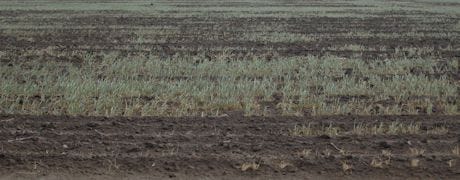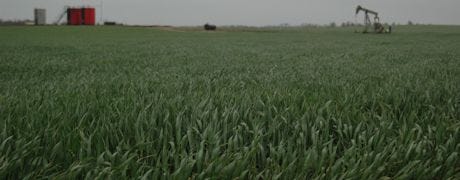
The first day of the 2013 Wheat Quality Tour wrapped up with a meeting in Colby on Interstate 70 in western Kansas. The 20 groups made up of 80 people from various farm groups, agribusinesses and publications all reported similar findings – the further west they traveled, the drier the soil and the lower the potential yield.

Many wheat fields like this one in Wichita County had spotty stands and showed signs of drought damage.
However, Kansas State University professor and agronomist Jim Shroyer informed participants Wednesday would reveal more damage. He was right. Along with colder weather, wind and rain, the two western tiers, along Highways 27 and 25, the winter wheat crop has been the hardest hit by drought. During the tour, temperatures dropped to 30 degrees Fahrenheit in some places, with strong winds, rain and some reports of snow.
For groups driving down Highway 25 to Garden City, potential yields were as low as 18 bushels an acre, with spotty stands and some of the winter wheat crop not having emerged. This is mostly due to the ongoing drought in the western reaches of Kansas, although some freeze damage was also apparent.
A transition in the winter wheat crop from west to east
Shrowyer also noted the situation would improve traveling further east. After crossing into Finney County and arriving in Garden City, yield calculations showed an improvement. More freeze damage was present, with the wheat being further along, although in the pre flag stage. Moving further east, fields showed less severe damage from freeze and more promising yields.

This field in Pratt County showed a huge improvement on soil moisture over the western tiers of Kansas.
Traveling east on Highway 156, the transition was apparent in Hodgeman County, and even more so in Pawnee, Stafford and Pratt counties in central Kansas. Some yield calculations reached the mid to upper 50s with more soil moisture.
Post-Drought Livestock, Range And Pasture Insight. No single group of producers has been more impacted by the 2012 drought than those who raise livestock. Download our FREE report, 5 Post-Drought Strategies For A Better 2013.
About the Author(s)
You May Also Like






